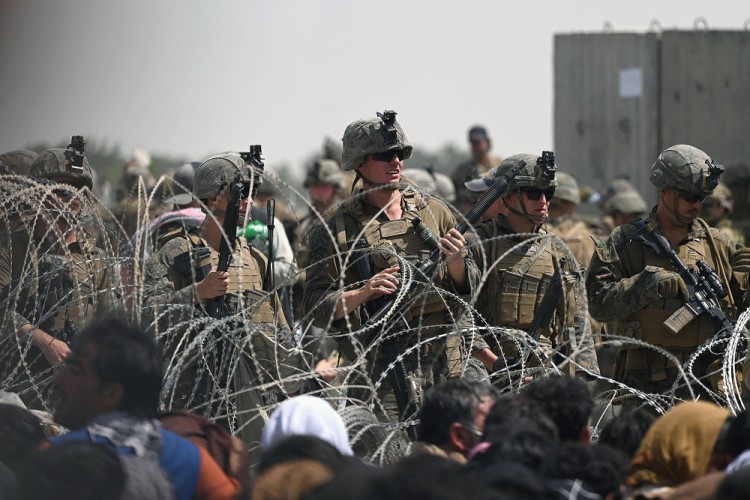
A ‘Digital Dunkirk’ to evacuate Afghan allies
Amy Mackinnon
Published:22 Aug 2021, 10:51 AM

A ‘Digital Dunkirk’ to evacuate Afghan allies
For Mike Jason, it began as an effort to help a senior officer in the Afghan army flee the Taliban. A retired U.S. Army colonel, Jason had attended the Institute for Higher Defense Studies in Rome with the Afghan officer years ago. This week, when the Taliban completed a dramatic takeover of the country, he received word that the officer had gone into hiding.
Jason quickly activated his network of former army pals over email and social media to make sure the officer would be allowed to get through the gates of Hamid Karzai International Airport (HKIA) in Kabul.
Since then, he and hundreds of other U.S. veterans, including West Point graduates, have been mobilizing on behalf of vulnerable Afghans in a kind of “digital Dunkirk,” as some are calling it, after the World War II effort by private vessels to evacuate British and other Allied forces from the embattled French port. “We just built this network to figure out who’s going to get my buddy through the gate [at the Kabul airport],” Jason told Foreign Policy. “And we just realized, there are a ton of other people doing it too.”
The network has quickly grown to include others who worked with Afghans over the years and now find themselves agonizing over the risk of retribution posed to their friends and former colleagues across Afghanistan. “It spans everything from former policymakers to NGO workers to academics to personnel on the ground at HKIA,” said Nick Calbos, a West Point graduate who served in Afghanistan in 2012 and 2013. A network of West Point graduates has set up a website called Allied Airlift 21 with step-by-step guidance for Afghans looking to get out.
Nearly 6,000 U.S. troops have now been deployed to secure the airport and assist with the evacuation, and U.S. forces have taken over air traffic control. By Thursday, the U.S. Defense Department said it had airlifted 7,000 people out of the Afghan capital over the past five days, while State Department spokesperson Ned Price said there were an additional 6,000 people at the airport cleared for evacuation.
While the airport has been secured, the gauntlet of Taliban checkpoints and the gates of the Kabul airport remain a “gray zone” where many veterans are focusing their efforts, according to Calbos. “We’ve collaborated with other organizations … to establish a process to assist high-risk individuals to navigate to the airport and get to the right place at the right time so those Marines, paratroopers, and diplomats on the ground can do the difficult job of identifying them and getting them through,” he said.
On Tuesday, U.S. National Security Advisor Jake Sullivan said the United States had secured guarantees from the Taliban that they would allow civilians to get to the airport safely. But the Taliban have only basic crowd control methods, using sticks, whips, and gunfire to disperse the crush of people.
On Wednesday, having shredded photos depicting her family members with Americans—which Johnson said would amount to a “death sentence” if found—the woman made her way to the airport while Johnson back-channeled with contacts at the State Department to try to ensure that someone would let her through the gate.
“The mother said she was getting stepped on and jostled in the 90-degree heat and after about five or six hours she gave up,” he said. The woman’s daughter later found out that her mother had briefly passed out in the crush.
“I thought the digital Dunkirk thing was a compelling bit of phrasing, but Dunkirk was boats, and people could just go to the shore and get on. We’re talking about a landlocked country that people are trapped in,” Johnson said.
Christina Tamayo, a U.S. military veteran involved with Allied Airlift 21, said one of the biggest challenges was keeping people’s spirits up while they waited at the gates of the Kabul airport amid scorching heat, large crowds, and Taliban gunmen. “It’s about hope. You must give them hope. The longer that hope is an ember, it can grow into a fire,” she said.
Tamayo, who is considering deferring a semester of her MBA to focus on the evacuation efforts, said she spends her days talking to officials and congressional aides in Washington. Early evening is “go time” as dawn is breaking in Kabul, she said. Then, “it’s just an all-night rager where we’re talking to on-the-ground assets.”
During 20 years of war, hundreds of thousands of Afghans have worked with Americans in the country, with the allied Afghan government, or with U.S. private contractors. But many have lost contact with their former employers or don’t have the language skills to reach out to those in the United States.
“There’s a big class element to this whole thing. If you look at the photos of these crowds, a small percentage of them have high-ranking and powerful Americans that are going to bat for them back home,” Johnson said.
Volunteer organizations such as No One Left Behind have worked for years to assist people who interpreted for the U.S. military to apply for special immigrant visas. According to the group, more than 300 interpreters and their family members have been killed over the years because of their links to the United States.
* Amy Mackinnon, a national security and intelligence reporter at Foreign Policy